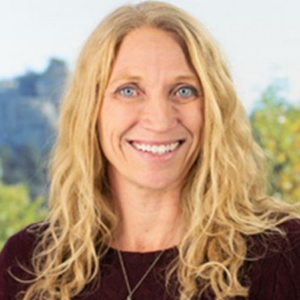“Inside the Classroom” with Holly Hereau
September 18, 2020

Meet Holly Hereau, a BSCS Science Educator focused on instructional materials development. Before joining the team, she spent 14 years teaching high school and community college science. She was recently named a Presidential Award for Excellence in Mathematics and Science Teaching (PAEMST) recipient for her outstanding work inside the classroom. PAEMST is the highest award given by the United States Government to kindergarten through 12th grade teachers of mathematics and science, including computer science.
What drives you as an educator, both inside and outside the classroom?
Until relatively recently, I probably would have given the same “when the students get that ‘aha’ moment” answer that most teachers say when asked this question. I think my answer is still that… but it means something different now than what it would have before. The ‘aha’ moment now for me is when students realize they have the power to figure things out. It’s not just getting that tough concept, or getting a good grade, but it’s the confidence that they can get all kinds of hard things by asking questions and investigating.
How did you make an impact as a teacher?
I facilitated projects that gave students agency, as well as the opportunity to connect with their place by planning environmental stewardship action projects, engaging in citizen science, and presenting their work to the larger community. The science experiences I was able to provide for students positioned them to see that the entire class was an important part of the ideas we were putting together — and that their own ideas were unique and valuable. My classroom was always a safe place for students; they knew I cared about them and would go to bat for them. I practiced empathy. I listened to student ideas and responded in ways that showed I was listening carefully to understand what they were thinking so we could build from that. While the “big” things like “detracking” science in our building may not continue to have an impact now that I’m gone, my interactions with students will hopefully stay with them and inform how they interact with the world.
How has your teaching experience shaped your approach to instructional materials development at BSCS?
Since I started doing work with NGSS designed materials and storylines, I started to see students who didn’t think they were good at science (or good at school even) realize they actually WERE good at science, and they were really good at figuring stuff out. I had several students enroll in AP Biology and AP Environmental Science after taking my Biology class who had never taken any honors or AP classes before. When asked about it, one student said it’s “because of the way we learn in here. We get to answer our own questions. I never thought I was good at science before. I wish all of my science teachers would have taught like this.” (if only we knew then what we know now!!) On the flip side, I also had 4.0 students who were “good at school” start to relax about their grades and focus on what and how they were learning. I felt like I could spike the football when an AP Bio student (who previously asked me about their grades every other day as a Biology student the previous year) was helping a new-to-our-school student who was frozen when asked to create an initial model to show what happens to a sandwich when we eat it. “Oh it’s OK, you’re not really supposed to know the answer right now. Just put down what you think. We’re making these models so we can figure out what we don’t know.” Those experiences don’t necessarily speak to my skill as a teacher, but to the quality of the materials I had access to. Using high quality materials (with an understanding of how and why) is the extended professional learning necessary to REALLY understand what phenomenon/problem based learning FEELS like, and I want all teachers to have access to that experience.
As I am writing instructional materials at BSCS—whether it is for middle or high school science—I constantly think of what it felt like as a teacher to realize how big this shift was. I think about the huge potential for all students to engage in and be interested in science in a way that I really hadn’t seen as a teacher before.
Times are tough. What advice do you have for teachers today?
Stop letting the stress of the “thousand little cuts” get to you. You know what is best for students. Do that. This year will be tough, and everyone has a different hard situation. Don’t let content dictate the way you interact with students. Rushing through a lot of material is not good for learning or for happiness. If a student gets to college without learning the phases of mitosis, it’s not the end of the world. Make sure students feel safe, and that they are learning about things they care about.
What most excites you about the future of science education?
I am so excited about the materials we are developing and the idea that so many students will experience science learning in this way. I’m really looking forward to seeing what happens with the OpenSciEd project in the future—for High School because that is the grade level I taught most, but also for elementary teachers and students. For too long, science has gotten pushed aside for math and reading—and there wasn’t much of a fight because there aren’t as many elementary teachers that are science specialists. I think having access to these materials removes part of the barrier to kids getting science. I’m excited to see how we can highlight math and literacy in those lessons to help convince teachers and districts that math and literacy learning can be supported and enhanced by DOING science!